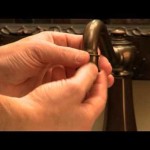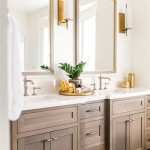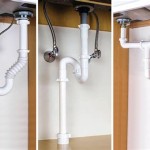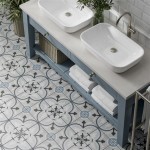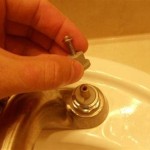How To Attach Mirror Bathroom Tiles
Installing mirror tiles in a bathroom can enhance the space, making it appear larger and brighter. The process requires careful planning, the right materials, and meticulous execution to ensure a durable and aesthetically pleasing result. This article provides a comprehensive guide on how to correctly attach mirror bathroom tiles.
Planning and Preparation
Before commencing installation, thorough planning is crucial. This involves accurately measuring the area where the mirror tiles will be placed. It is imperative to determine the number of tiles needed, accounting for potential cuts and wastage. When purchasing tiles, it is recommended to acquire approximately 10% more than initially calculated to accommodate any errors during the cutting or installation process.
The condition of the wall surface is also a significant factor. The wall must be smooth, clean, and structurally sound. Any existing paint, wallpaper, or residue should be removed. If the wall is uneven, it must be leveled using a suitable patching compound and allowed to dry completely before proceeding. A primer can be applied to the wall surface to improve adhesion and prevent moisture absorption, especially in humid bathroom environments.
Gathering the necessary tools and materials is a critical step. The following items will be required:
- Mirror tiles
- Mirror adhesive
- Level
- Measuring tape
- Pencil
- Tile cutter or glass cutter
- Safety glasses
- Gloves
- Notched trowel
- Spacers
- Clean cloths or sponges
- Mild cleaning solution
- Silicone sealant (optional)
Adequate ventilation is essential during the installation process, particularly when using adhesives and sealants. Open windows or use a ventilation fan to ensure proper airflow.
The Installation Process: Applying the Adhesive
The correct application of adhesive is paramount for securely attaching mirror tiles. The adhesive must be specifically designed for mirrors to prevent damage to the reflective backing. General-purpose adhesives may contain solvents that can degrade the mirror’s silvering, leading to discoloration and deterioration over time. Always consult the adhesive manufacturer’s instructions for specific application guidelines and drying times.
Begin by laying out the tiles on the floor in the desired pattern to visualize the final appearance and make any necessary adjustments. Use spacers to maintain consistent grout lines, ensuring a professional finish. Then, transfer the layout to the wall using a level and pencil to mark the position of each tile. This step is crucial for maintaining straight lines and preventing misalignment.
Using a notched trowel, apply a thin, even layer of mirror adhesive to the back of each tile. The notched pattern helps to create channels for air to escape, preventing air pockets and ensuring better adhesion. Avoid applying excessive adhesive, as this can squeeze out between the tiles and make cleanup more difficult. The amount of adhesive should be sufficient to cover approximately 80% of the tile’s surface.
Carefully position the first tile on the wall, aligning it with the marked guidelines. Press the tile firmly against the wall for several seconds to ensure initial adhesion. Use a level to verify that the tile is straight and adjust its position as needed. Insert spacers between the tiles to maintain consistent grout lines. Proceed to apply adhesive to successive tiles, following the established layout and using spacers for even separation.
For larger tiles, consider applying a vertical bead of adhesive directly to the wall in addition to the adhesive on the back of the tile. This can provide extra support and stability, especially in areas prone to moisture or temperature fluctuations. Regularly check the alignment of the tiles with a level to ensure a uniform and professional finish. After placing a row of tiles, use a long level to ensure the entire row stays horizontal.
After all tiles are affixed, allow the adhesive to cure completely according to the manufacturer’s instructions. This typically takes 24 to 48 hours. During this period, avoid any activity that could disturb the tiles or apply pressure to the surface. Placing painter's tape across the tiles can give additional temporary support while the adhesive cures.
Cutting and Finishing
Often, mirror tiles may need to be cut to fit around fixtures, corners, or edges. Cutting mirror tiles requires specialized tools and techniques to avoid cracking or shattering the glass. Safety is paramount; always wear safety glasses and gloves when cutting tiles.
A tile cutter or glass cutter is the preferred tool for scoring the tile. Accurately measure the required cut and mark the line on the tile’s surface with a permanent marker. Place the tile on a flat, stable surface and use the cutter to score a clean, continuous line along the marked line. Apply firm, even pressure to the cutter while scoring.
After scoring, gently snap the tile along the scored line. Several techniques can be used to accomplish this: using running pliers, lining up the score over the edge of a table and pressing down on either side of the score, or using a tile nipper tool to slowly remove small slivers of the edge.
If a more precise cut is needed, a wet saw with a diamond blade can be used. This provides a clean, smooth cut and is particularly useful for cutting curved or irregular shapes. Always wear safety glasses and follow the manufacturer’s instructions when using a wet saw. When using a wet saw, apply slow, steady pressure to the tile, allowing the blade to do the work. Avoid forcing the tile through the blade, as this can cause chipping or cracking.
After the adhesive has fully cured, remove the spacers and inspect the tiles for any imperfections or misalignments. Clean the surface of the tiles with a mild cleaning solution and a soft cloth or sponge. Avoid using abrasive cleaners, as these can scratch the mirror surface.
Once the tiles are clean and dry, apply a bead of silicone sealant along the edges where the tiles meet the wall or other surfaces. This will prevent moisture from seeping behind the tiles and can help to secure them further. Ensure the sealant is specifically designed for use in bathrooms and is mold-resistant. Smooth the sealant with a wet finger or a sealant smoothing tool for a neat and professional finish. Allow the sealant to cure completely according to the manufacturer’s instructions.
Carefully inspect the finished installation for any defects or areas that need attention. Touch up any imperfections and ensure that all surfaces are clean and dry. The newly installed mirror tiles will enhance the aesthetics of the bathroom, creating a brighter and more spacious environment.
Regular maintenance is important to prolong the life of the mirror tiles. Clean the surface regularly with a mild cleaning solution and a soft cloth. Avoid using abrasive cleaners or sharp objects that could scratch the mirror surface. Inspect the sealant periodically and reapply as needed to prevent moisture damage.

How To Hang A Mirror On Tile Wall Remington Avenue

Tutorial How To Hang A Bathroom Mirror The Diy Playbook

How To Hang Mirrors On Tile 3 Ways A Bonus The Palette Muse

How To Hang Mirrors On Tile 3 Ways A Bonus The Palette Muse

Diy Mosaic Tile Bathroom Mirror Centsational Style

Tutorial How To Hang A Bathroom Mirror The Diy Playbook

How To Hang Mirrors On Tile 3 Ways A Bonus The Palette Muse

How To Hang A Bathroom Mirror Over Tile Wainscoting Mimzy Company

Diy Mirror Frame With Glass Mosaic Tile Armchair Builder Blog Build Renovate Repair Your Own Home Save Money As An Owner

How To Hang A Bathroom Mirror Over Tile Wainscoting Mimzy Company
Related Posts

